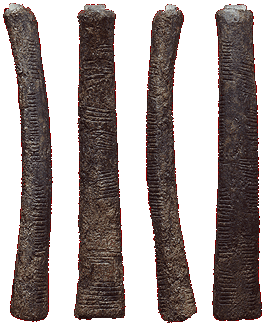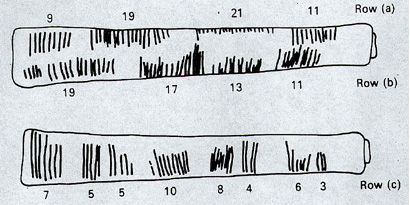| Most histories of mathematics devote only a few pages to Ancient Egypt and to northern Africa during the 'Middle Ages´. Generally they ignore the history of mathematics in Africa south of the Sahara and give the impression that this history either did not exist or, at least, is not knowable, traceable, or, stronger still, that there was no mathematics at all south of the Sahara. In history, to Europeans, even the Africanity of Egyptian mathematics is often denied or suffers eurocentric views of conceptions of both 'history' and of 'mathematics' form the basis of such views. High in the mountains of Central Equatorial Africa, on the borders of Uganda and Zaire lies Lake Edward, a source of the Nile. It is a small lake (about 30 miles by 60 miles). |  click map to download an expanded view click map to download an expanded view | ||||
| Though the area is sparsely populated today, approximately 25,000 (update from 9,000) years ago by the shores of the lake lived a small community that fished, gathered, and grew crops The settlement only existed a few hundred years before being buried in a volcanic eruption. The place where their remains were found (1960) has a name now given to these people - Ishango. Among their remains is the second oldest mathematical object (the oldest is here) in Africa. Some say that the Ishango Bone is the oldest table of prime numbers. Marshack later concluded, on the basis of his microscopic examination, that it represented a six-month lunar calendar.
prime numbers or menstral calendar
| |||||
 |  | ||||
 | |||||
BACK TO The Ancients in Africa
|
The following dating information was sent by email from Professor Charles Finch:
The site where the Ishango Bone was found was re-dated by Alison Brooks more than a dozen years ago and found to be 25,000 years old rather than the original estimate of 8,500 years. However, the Lembombo Bone in Swaziland is still 10,000 years older, consistent with iron ore mining there going back 43,000 years ago. Proto-mathematics begins in Paleolithic Central and Southern Africa.
references:
- Shreeve, "The Dating Game," Discover, September 1992, pp. 76-83.
- Alison Brooks, "Dating and Contex of Three Middle Stone Age Sites with Bone Points in the Upper Semliki Valley, Zaire," Science, 4/28/95, pp. 548-52.
references for this web page:
- AMUCHMA-NEWSLETTER-9: http://www.math.buffalo.edu/mad/AMU/amu_chma_09.html
- J. de Heinzelin, Ishango, Scientific American, 206:6 (June 1962) 105--116.
- J. Shurkin, Engines of the mind: a history of the computer, W. W. Norton & Co., 1984., p21
- J. Bogoshi, K. Naidoo and J. Webb, The oldest mathematical artifact, Math. Gazette, 71:458 (1987) 294.
- Claudia Zaslavsky, Women as the First Mathematicians, the Women in Mathematics Education Newsletter,Volume 7 Number 1, January 1992.
Since opening 5/25/97,  visitors to
visitors to
The web pages
MATHEMATICIANS OF THE AFRICAN DIASPORA
are brought to you by
MATHEMATICIANS OF THE AFRICAN DIASPORA
are brought to you by
The Mathematics Department of
The State University of New York at Buffalo.
The State University of New York at Buffalo.
They are created and maintained by
Scott W. Williams
Professor of Mathematics
Scott W. Williams
Professor of Mathematics
No comments:
Post a Comment